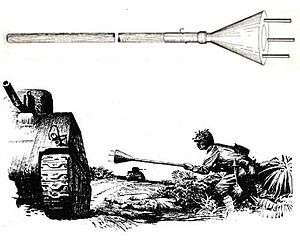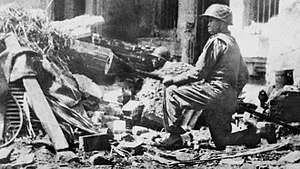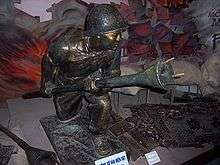Lunge mine
The Shitotsubakurai lunge mine was a suicidal anti-tank weapon developed and used by the Empire of Japan during the Second World War. It used a HEAT type charge. This weapon was used by the CQC units of the Imperial Japanese Army. The weapon itself was a conical hollow charge anti-tank mine, placed inside a metallic container and attached to the end of a wooden stick. The weapon was officially adopted by the Japanese Army in 1945; in that year it caused its first victims in the Pacific Theater, where it commonly saw action against American armour. Later that year, some Japanese Imperial Army manuals of the weapon were discovered by US troops.[1][2]
| Lunge mine | |
|---|---|
 A drawing of a lunge mine and its operation | |
| Type | Suicidal anti-tank mine |
| Place of origin | |
| Service history | |
| In service | 1944–1975 |
| Used by |
|
| Wars | |
| Production history | |
| Designed | World War 2 |
| Specifications | |
| Mass | 6.48 kg |
| Length | 130 cm |
| Height | 0.305 m |
| Diameter | 0.08 m |
| Filling | TNT |
| Filling weight | 4.5 kg |
Detonation mechanism | Three ZDZ 29 pressure fuzes |
Design
The weapon itself was a conical hollow charge attached to one end of the weapon, which was a wooden stick used to hold the weapon during its transport and use. The mine had equally spaced three legs facing forwards, all around the conical explosive base of the weapon. The detonator of the weapon was situated at the end of the conical base.[1]
The mine was 30.48 cm in length, and the wooden stick was 99.06 cm, which made the total length of the weapon 129.54 cm. The mine had a diameter of 8 cm, and its body was about 3.175 cm in diameter. Its total weight was 6.48 kg, of which 2.948 kg were explosives.
Operation
To use the mine, the soldier would remove the security pin, and then charge the enemy armour, just like in a bayonet charge, making the top of the mine collide with the objective. The weapon needed to be held by the center with the left hand and by the bottom with the other hand. When the legs of the mine hit the objective, the handle was pulled forward, cutting a pin and making the detonator move forward to the detonator charge. This would set off the mine, blowing up its user and, probably, the targeted enemy armour.[1]
Armour penetration
The mine was capable of penetrating about 150 mm of RHA at an angle of 90º, and up to 100 mm at an angle of 60º. However, the mine would almost always impact at 90º because the impact angle with the objective would be decided by the weapon's user, and he would probably aim for a 90º armour plate.[3]
Combat record
The weapon was used by the Imperial Japanese Army during the later stages of the Second World War in the Pacific Theater against American armour, until the end of the war in 1945, the same year that the weapon was introduced into service. However, no report has been given which shows that it actually worked as a weapon.
The U.S. Intelligence reports in March 1945 that they met this weapon for the first time in Leyte island, The Philippines in 1944, and later in Manila as well. It also reports that "To date all attempts by the enemy to use the Lunge Mine against our tanks have met with failure" and rates it as "Perhaps the oddest of these antitank charges".[1]
In Vietnam it seems to be an icon of the First Indochina War, specifically during the Battle of Hanoi, together with a Battalion Commander Nguyen Van Thieng who tried to use it; however, "the bombs failed to explode. In the end, he was shot and heroically sacrificed".[4]
There are also some records of this weapon being used by the North Vietnamese soldiers during the Vietnam War, where it was also used against American armoured vehicles .
Photo Gallery
 Schematic of the mines components.
Schematic of the mines components. A Vietnamese soldier Nguyen Van Thieng holding a lunge mine at Hàng Đậu Street on December 1946.
A Vietnamese soldier Nguyen Van Thieng holding a lunge mine at Hàng Đậu Street on December 1946. A reproduction of an anti-tank lunge mine being used by Nguyen Van Thieng, a soldier of Vietnam National Defence Army, 1946.
A reproduction of an anti-tank lunge mine being used by Nguyen Van Thieng, a soldier of Vietnam National Defence Army, 1946.
References
- "New Weapons for Jap Tank Hunters (U.S. WWII Intelligence Bulletin, March 1945)". Lone Sentry. Archived from the original on 2017-09-29. Retrieved 2017-09-30.
- "Japanese Anti-Tank Assaults - The Chieftain's Hatch - World of Tanks official forum - Page 5". 2017-09-30. Archived from the original on 2018-07-30. Retrieved 2019-12-14.
- "WWII Japanese LUNGE MINE.........building a replica??". Archived from the original on 2017-09-29. Retrieved 2017-09-30.
- Explanatory board for replica of lunge mine held by a soldier at Vietnam Military History Museum, Hanoi; verified in December, 2019